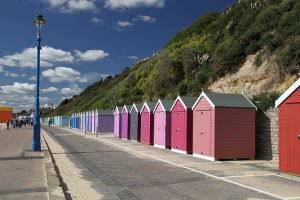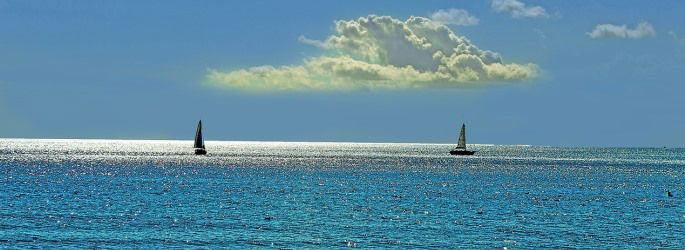A Brief History of The English Summer Holiday
The history of summer holidays is clouded with myths.
One popular idea is that school children have a long summer holiday (six weeks for most pupils in the UK) so that they could help work in the fields over the summer. But the current school system was developed over the course of the 19th century, when English farms were increasingly mechanised and having children helping with the harvest would only have been necessary for a small percentage of the population. Besides which, a brief glance at the farming calendar tells you that a holiday that ends at the start of September is not going to be much use for bringing in the harvest in the early autumn. So whatever the origin of six weeks off at the height of summer is, it’s not for the sake of farmers. Perhaps it was just to be nice to school students by giving them time off at the sunniest part of the year.
So where did summer holidays come from, and how did our current idea of what school pupils should spend the months of July and August doing evolve? In this article, we take a look at five key points in the history of the great English summer holiday.
1. The Middle Ages: Holy-days and pilgrimages
You probably don’t think of the Middle Ages as being much of a time for holidays. In the popular imagination, it was about endless drudgery in unproductive mud, praying a lot, and everyone dying at the age of 30, interspersed with war and plague for a diversion. That’s unless you belonged to the nobility, in which case there was less drudgery in the mud, but more back-stabbing, and the possibility of dying a little further away from home in the Crusades.

While living in the Middle Ages didn’t have a lot to recommend it, there were more holidays that you might expect – and you’d get to enjoy more of them than you realise, as people who survived childhood (a tough ask) could expect to live to see their 60s or 70s. The word ‘holiday’ is derived from ‘holy day’, or a saint’s day in the Christian calendar, and holy days were an important part of medieval life. They could mean time off work and they certainly meant an excuse for a party.
And holy days were very frequent. To get an idea of just how frequent, the Church of England currently celebrates nine Principal Feasts, three Principal Holy Days, and 26 Festivals – that’s not counting Festivals and Lesser Festivals besides. To put it another way, that’s not significantly different from the 28 days of annual leave that full-time workers are entitled to in the UK at the moment. Of course, you wouldn’t necessarily get time off on all of these days (and there was no concept of a weekend, only of Sunday as a day of rest) but it certainly wasn’t a time of uninterrupted hard labour.
There was even the concept of going away for a holiday – not that people would have viewed it in those terms. Just as holy days were religious festivals, so the option of leaving your home to have fun seeing more of the world was done on the basis of a pilgrimage. That might be within England, to Walsingham (which women visited to pray for fertility) or Canterbury, or overseas, to destinations such as Rome or Jerusalem. Going on a pilgrimage was seen as a demonstration of piety, but it certainly wasn’t just for the pious. Chaucer’s famous Canterbury Tales tells the story of a group of pilgrims travelling to Canterbury, and while some of them are motivated by strong religious feeling, others just want to a chance to meet new people, spend time away from home, see a bit more of the world and enjoy themselves – much like people going on holiday today.
2. The 18th century: The Grand Tour
From the mid-17th century, following the Restoration of the Monarchy but peaking in the 18th century, the Grand Tour was a kind of sophisticated gap year for upper-class young men in Britain, and adopted by some Americans too. It consisted of a tour of Europe, accompanied by a guide called a Cicerone, usually from France, to Italy, to Germany and then back home (though a few of the more adventurous travellers went to Greece, and even in a few rare cases as far as Turkey). It usually lasted a few months, but some travellers went for several years.

This was the time of the Enlightenment, when the belief began to arise that knowledge was best derived from personal experience – so for example, seeing a picture of the Colosseum in a book did not impart the same degree of understanding as seeing it in person and forming your own impression. That might seem obvious, as those beliefs are still current today, but prior to the Enlightenment it was believed that reading something from a knowledgeable source was a much better education than trying to work the same things out for yourself.
The Grand Tour was an important part of this belief. Young men went on the Grand Tour after graduating from Oxford or Cambridge, and it was seen as an extension of their education. They visited historical sites, viewed works of art and architecture, practised their language skills, socialised in upper-class society across Europe, caught up with Continental fashion, took lessons in things like dancing or fencing, and collected a large number of souvenirs that could later be used to show off how cultured they were.
In some ways, the principles of the Grand Tour are still with us – what we do as tourists (visiting museums, buying souvenirs, practising our language skills and trying to absorb local culture) is strongly influenced by the aims of the Grand Tour. If you think that full experience of European culture requires having visited Paris, Rome and Venice, then you might be at home in the 18th century.
3. The 19th century: I do like to be beside the seaside
The proper tradition of the Grand Tour died out in the early 19th century. It was no longer just an option for the very wealthy (and therefore ceased to be as effective a status symbol), as it became easier, cheaper and safer. It started to be taken by young women as well as young men. There were still lots of people taking the Grand Tour, but the implications were gone; it had lost its social cachet. And it was all because of one single, straightforward reason: the coming of steam.

While steam – both in the form of trains and steamships – opened up Europe to the wealthy rather than just the very wealthy, in Britain it opened up travel to groups of people who had never really been able to enjoy it before. Workers had increasingly moved to the cities, where their hours were dictated not by the cycle of the seasons and what was required on a farm, but imposed by managers in factories. That meant the structured allocation of time off, which in combination with significantly cheaper travel, led to the creation of what became the traditional British seaside holiday. The Bank Holidays Act of 1871, providing nationwide statutory days off, made this even easier. Wealthier people went on holiday for a week and stayed in hotels, but a day ticket to the seaside was affordable for the majority of people.
The belief at the time that sea air was good for your health motivated a lot of people to travel to the seaside for their holidays. Beyond that, the things that attracted people to beach holidays were much the same as attract them today: the chance to paddle or swim in the sea, to mess about on the beach building sandcastles, to meet new people, to see shows and to get a change of scenery. Some people went to quieter areas and enjoyed hobbies like painting; others went to popular resorts like Blackpool, Scarborough and Southend where a whole entertainment industry sprung up to cater to tourists.
4. The 20th century: International travel on a shoestring
Seaside holidays in the UK began to fall out of fashion in the mid-20th century as international travel increasingly became affordable to the same class of people who had travel opportunities newly opened up to them by the railways a century before. Air travel in the 1960s was still much more expensive than it became from the 1990s, when the deregulated air travel market allowed budget no-frills airlines to cut costs significantly, but it was far more affordable than international travel had been previously.

Travel agencies had first appeared in Victorian times, allowing tourists to book all-inclusive or package holidays for a fixed cost and without needing to plan their own route or choose their own hotels. These came into their own in the 20th century, where they could use economies of scale to bring the costs of air travel and hotel stays down considerably. And it wasn’t just that the cost of an international holiday was reduced; ordinary people were enjoying the use of more disposable income than ever before. Alongside international holidays by plane, cruises were also popular.
In a way, the international travel of the 20th century looks quite a lot like a condensed version of the Grand Tour. Sunning yourself on a beach wasn’t officially part of the Grand Tour, but the other aspects of 20th century mass tourism were – seeing the sights, absorbing the culture and so on. The popular destinations for tourists of the 20th century weren’t so different from those in the 18th; Paris and Rome have maintained their popularity.
At the same time, the 19th century beach holiday was transplanted outside the UK, to countries that enjoyed much better weather. On a practical level, a much greater percentage of the population knew how to swim, so having weather that was good enough for swimming in the sea (rather than just paddling) became a consideration, and that meant travelling somewhere with more reliable weather. Being tanned also became fashionable in the 20th century, when previously being pale had been seen as more attractive. Many of the norms of travel in the 20th century still apply, but there are new trends too…
5. The 21st century: Nostalgia and staycations
The next big trend in travel is tricky to predict. After all, the defining travel theme of the 20th century – mass international travel – didn’t really take off until midway through the century. So it may take until 2050 before the holidays of the 21st century will actually come about. It may be that the work of SpaceX, and to a lesser extent Virgin Galactic and Blue Origin, succeeds and in 2050 more adventurous travellers are taking breaks exploring the surface of the Moon, and by 2080 they’re immersing themselves in the unique culture of the Mars colony. Fingers crossed!

But there are some trends, particularly in the UK, that we can already see from the first few years of the 21st century. Someone on a typical middle-class income in the UK can now afford to travel all over the world, and the choice of travelling to Bali or Mexico or Croatia might be dictated not by cost, but – for example – how much you enjoy eating spicy food. Travel is no longer quite the status symbol it once was.
One cultural development has been nostalgia holidays and staycations. A ‘staycation’ involves spending a holiday at home. That could be loosely defined as ‘in the UK’ or literally in your hometown, visiting local attractions rather than going somewhere new (the assumption being that you’ll have done most of the stops on the Grand Tour, but you might never have been into your local museum).
This ties in with nostalgia holidays, in which people take the kind of holiday that their grandparents might have done. Nostalgia holidays might involve travelling on canal boats or steam trains, or they might involve recreating the traditional seaside holiday, with a sense of ironic enjoyment. Some companies even offer holidays themed around a particular decade. This usually means 1940s or 1960s, rather than getting to go on a pilgrimage of the 1380s – but give it time. Perhaps, one day, that too will catch on.
Image credits: seagulls; sea; baby chicks; florence; beach huts; flip flops; mr whippy;

